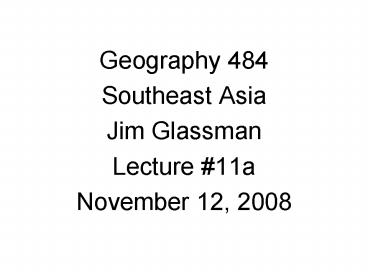Geography 484 - PowerPoint PPT Presentation
1 / 14
Title:
Geography 484
Description:
What are the major causes of the 1997-98 Asian economic crisis, according to ... Emphasis on ... why didn't corruption stall growth before? Neo-Weberian ... – PowerPoint PPT presentation
Number of Views:32
Avg rating:3.0/5.0
Title: Geography 484
1
- Geography 484
- Southeast Asia
- Jim Glassman
- Lecture 11a
- November 12, 2008
2
Discussion question
- What are the major causes of the 1997-98 Asian
economic crisis, according to your understanding?
3
(No Transcript)
4
(No Transcript)
5
Different theoretical approaches to the Asian
economic crisis
- Neo-liberal approaches
- Neo-Weberian approaches
- Marxist approaches
- Neo-Marxist (geographical-historical materialist)
approaches
6
Neo-liberal approaches
- Emphasis on subversion of market forces
- Nepotism, corruption, lack of transparency as
causes of problem - Further liberalization as solution
- Problem why didnt corruption stall growth
before?
7
Neo-Weberian approaches
- Emphasis on subversion of state by international
capital - Increased FDI and portfolio investment, loans
- Pressures on state to loosen grip
- Liberalization as cause of problem
- Large flows of capital destabilizing
- Changing rules of game (by West)
- Reassertion of role for state as solution
- Deflationary policies of IMF hurt, not help
- Need for Tobin tax?
- Problem why were states suddenly unable to
control capital?
8
Marxist approaches
- Emphasis on class and class-relevant struggles
- Crises in general reflect class character of
capitalism - Declining profits profit squeeze vs.
overinvestment - Crisis tendencies of capitalism are deepest
causes of problem - Class struggle and profit squeeze
- Overinvestment, declining profits
- Revolutionary struggle as solution to problem
- Problem did national class struggles cause
downturn?
9
Neo-Marxist approaches
- Emphasis on changing geographical-historical
conditions - End of Cold War
- Slow-down of Japan
- Rise of China as competitor
- Social struggles in this context as causes of
crisis - Labor struggles and competition from China
- Political struggles in post-Cold War state
- Regionalized/internationalized social struggles
as solution - Problem Were all countries affected in this same
way?
10
(No Transcript)
11
(No Transcript)
12
Causes of falling profit rates
- Economic slowdown in Japan
- Increasing competition from China, Mexico
- Rising wages
- Export slowdown of 1996
13
Outbreak of crisis in Thailand
- Rising wages, overcapacity, declining profits
- Financial liberalization of 1990s
- Portfolio inflows and real estate inflows
- Boom in land speculation
- Falling exports in 1996
- Collapse of property and stock markets
- Currency traders vs. Bank of Thailand
- Baht devalued, loses half of its value
- IMF called in for 17 billion stabilization loan
- IMF policies throw gasoline on flames?
14
The spread of the crisis
- Contagion effects spread crisis throughout region
- Investor panic and crises in stock markets and
currency markets throughout region - IMF 25 billion stabilization package in
Indonesia - Countries less affected by crisis
- The Philippines mini-crisis
- Malaysia affected but refused to go to IMF
- Singapore relatively unaffected
- Transition economies affected but not heavily































